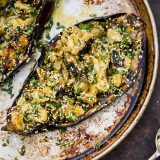Hauntingly good is not a term I often use to describe eggplant.
Yet, during a recent five-day visit to Israel, over and again I encountered eggplant dishes for which I had no other words. The dishes were slightly different at each stop, but one constant connected them—a savory smokiness that permeated every bite.
At Gargir Hazav, a hummus shop in Tel Aviv’s Levinsky Market, where spices, dried fruit, pastries and crowds jostling for them all abound, it took the form of a baba ghanoush- like puree that was spooned over fresh, warm hummus.
And at Ein Hod, a rural Arabic restaurant known as much for its 25-course meals as its views of the Mediterranean Sea, it appeared as a charred eggplant, intact, with only the top sliced off, covered with tahini, parsley, olive oil and paprika.Elsewhere, it served as a smoky, warm bed for grilled meats.
In each case, it was the depth of that smoke—and the simplicity with which the eggplant was presented—that impressed me.
I finally understood what I’d been tasting when I visited a tiny unnamed lunch spot on the margins of Tel Aviv’s sprawling Carmel Market, an aromatic warren of produce, spice and falafel stands.
The restaurant is run by Irit Aharon, who prepares simple Israeli dishes. Her business was closed the day I visited, but she was happy to demonstrate the eggplant dish for which she is best known.
The prep portion of the demo was shockingly short. Aharon grabbed a large eggplant and set it directly onto the grate of a gas burner on her stove. The flame was set to low. Every five or so minutes, she used tongs to rotate it. That’s it. Nothing more for 20 minutes.
The eggplant blistered, blackened and cracked, steam jetting out. It sunk into itself. The kitchen—really just a corner of the eatery with a stove—smelled of char.
Eventually she transferred the eggplant to a cutting board and let it cool a bit before slicing and peeling away. The result wasn’t pretty, a pulpy mass of naked eggplant.
She dressed it simply—lemon juice, salt, minced garlic, tahini, fresh oregano. We ate it sitting at a small table on the street outside. For so little effort, so few ingredients, the flavor was deeply complex. Smoky, charred and bold, yet lightened by the lemon and herb. With a texture somewhere between stewed tomatoes and butter, it begged to be slathered on toasted bread.
The dish had no name. Irit’s eggplant? She shrugged. Turns out, it’s a method common to the region. Whole eggplants roasted directly over open flame.
Back at Milk Street, we were reluctant to risk the mess of charring our eggplant directly on the burner, so with summer in mind, we moved the cooking to the grill. It worked splendidly. (And for the grill-averse, we also came up with an indoor broiler alternative.)
We also halved the eggplants lengthwise, which gave us more area to char and made it easier—and more attractive—to serve. This also offered us the chance to score the eggplant flesh, allowing us to work a mix of garlic and olive oil deeper into it, amping up the flavor even more.
We kept the seasonings mostly the same, with plenty of parsley, lemon and olive oil. We also liked the bright note of fresh mint. But rather than tahini, we backed up and sprinkled on toasted sesame seeds. We liked the contrast the crunchy seeds offered to the soft flesh.




